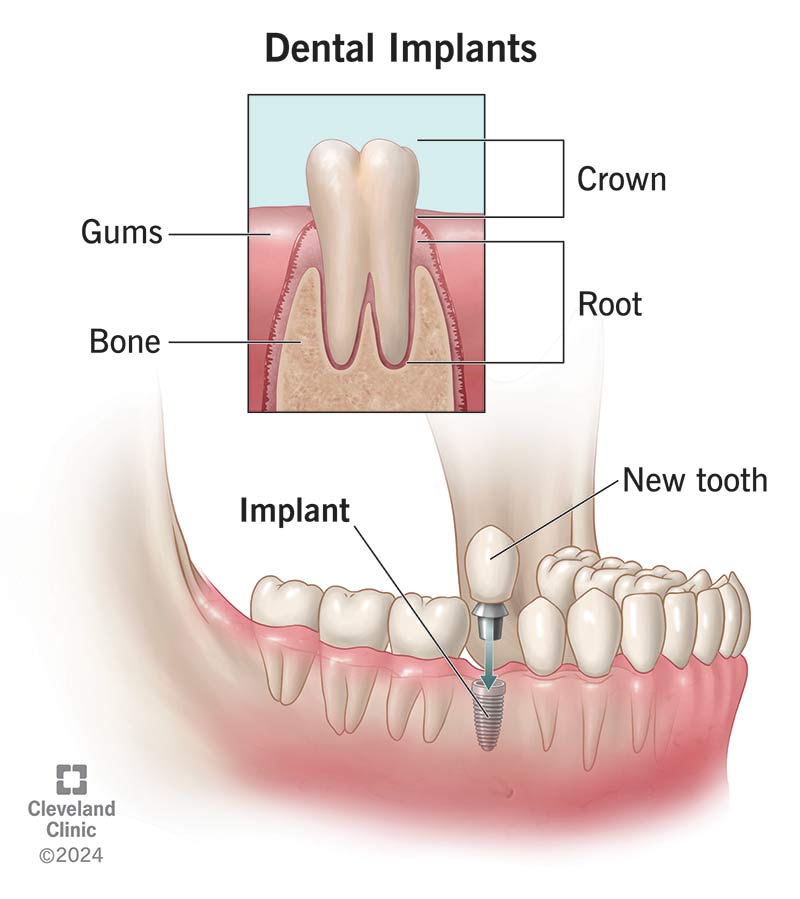Fascination About Dental Sense
Fascination About Dental Sense
Blog Article
5 Easy Facts About Dental Sense Described
Table of ContentsThe Best Strategy To Use For Dental SenseTop Guidelines Of Dental SenseThe Best Guide To Dental SenseThe Best Strategy To Use For Dental Sense
are clinical gadgets operatively dental implanted into the jaw to recover a person's ability to chew or their look. They supply support for man-made (fake) teeth, such as crowns, bridges, or dentures. When a tooth is shed due to injury or illness, a person can experience problems such as rapid bone loss, defective speech, or changes to chewing patterns that result in discomfort.Oral implant systems include an oral implant body and oral implant abutment and may likewise consist of an abutment fixation screw. Root canal procedure. The oral implant body is surgically put in the jawbone instead of the tooth's root. The oral implant joint is generally connected to the implant body by the joint fixation screw and prolongs with gums right into the mouth to support the connected artificial teeth
(http://peterjackson.mee.nu/where_i_work#c2504)Framework of The Dental Implant System choosing dental implants, speak with your dental service provider concerning the potential benefits and dangers, and whether you are a candidate for the procedure. Points to consider: Your general health and wellness is an essential aspect in establishing whether you are an excellent candidate for oral implants, how much time it will take to recover, and how much time the implant may remain in place.
Smoking might impact the recovery process and decrease the long-term success of the implant. The healing procedure for the implant body may take numerous months or longer, during which time you normally have a temporary abutment in place of the tooth. the oral implant treatment: Very carefully comply with the oral hygiene instructions provided to you by your dental service provider.
Dental Sense Can Be Fun For Anyone
Implant failure can lead to the need for an additional surgical treatment to fix or replace the implant system. Recovers the ability to eat Brings back aesthetic look Helps maintain the jawbone from reducing due to bone loss Preserves the health of the surrounding bone and gum tissues Aids maintain surrounding (nearby) teeth stable Improves high quality of life Damage to surrounding all-natural teeth throughout dental implant positioning Injury to the surrounding cells throughout surgical procedure, such as sinus opening Injury throughout surgery (for example, fracture of bordering jawbone) Inadequate feature, such as seeming like the teeth do not attack with each other usually An experience that the tooth hangs or twisting in location resulting from an abutment screw loosening Implant body failing (looseness of the implant body) due to systemic infection, which might be most likely in individuals with unrestrained diabetes as a result of neighborhood infection in bone and gums sustaining the dental implant body as a result of delayed recovery, which might be more probable in individuals who smoke Trouble cleaning the gums around the implant, leading to bad dental the original source hygiene Neglected gum illness Post-surgical pins and needles because of nerve impingement or damage Constantly notify health and wellness care providers and imaging specialists that you have dental implants prior to any magnetic resonance imaging (MRI) or x-ray procedures.
FDA is not familiar with any unfavorable events reported for MRI or x-ray treatments with oral implants. Dental implants systems are normally made from products that adhere to international agreement criteria of the International Organization for Standardization (ISO) or ASTM International. These standards have details of what makes a secure material.

A dental implant is a framework that replaces a missing tooth. With screw-like devices, the surgeon inserts an implant into the jawbone, and it acts as an anchor for a man-made tooth, called a crown.
How Dental Sense can Save You Time, Stress, and Money.
Some people are not eligible for oral implant surgery. It is for oral surgeons to operate individuals with: severe illnessuncontrollable metabolic diseasebone or soft tissue condition or infectionIf these problems are settled, an individual can have the surgical treatment. In, dental doctors refrain from operating people with: If individuals with any of the above undergo dental implant surgery, there is a greater threat of the implant falling short.

Oral dental implant surgery is an individualized procedure. Offer you time to recover. Attach the article and final crown, bridge or denture.
Next off, your cosmetic surgeon will carefully position the oral implant right into your jaw. Your doctor will certainly reposition your gum tissues and close the incision with stitches. If your dental implant is near the front of your mouth, your dental practitioner will certainly make a short-lived tooth for you to use up until you recover. This way, you won't have a void in your smile while you recoup.
The Of Dental Sense
Your service provider can tell you what to expect in your circumstance. Throughout the recovery stage, your jawbone should fuse to the oral implant. This procedure, called osseointegration, is critical for security and long-term success. This process can take anywhere from 3 to nine months. In many cases, it may take much longer.
When your dental implant heals, your dentist can affix the abutment (tiny connector message) and your last reconstruction (crown, bridge or denture). This normally takes regarding one hour to complete and may call for a 2nd small surgery. You should not really feel any kind of discomfort during your dental implant treatment due to the fact that your service provider will utilize medicine to numb your periodontals.
Report this page